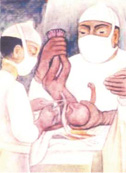The eLitMed.hu medical portal uses computer cookies for convenient operation. Detailed information can be found in the Cookie-policy.
Lege Artis Medicinae - 2005;15(11)
Content
[PREVENTION OF INFECTIONS IN CHRONIC HEPATITIS AND CIRRHOSIS]
[Patients with chronic liver disease, mostly the elderly, due to their impaired immune response, frequently suffer from infections worsening the clinical course. This is sometimes overlooked in the everyday praxis. In patients with alcoholic liver disease both hepatitis A virus (HAV) and acute hepatitis B virus (HBV) infections can lead to fulminant hepatic failure, therefore their immunization with HAV and HBV vaccines is highly recommended, similarly, vaccination against flu and pneumococcus also may be indicated for alcoholics. In chronic viral hepatitis, alcohol abuse can result in rapid progression to cirrhosis and reduces the efficacy of antiviral treatment. Patients with chronic hepatitis C should also be vaccinated against superinfections by HAV and HCV. Co-infections by hepatotropic viruses and human immundeficiency virus (HIV) are frequent due to the shared routes of transmission. In HIVpositive patients the efficacy of the vaccination against HAV and HBV depends on the CD4 cell count, which also determined the timing of anti- HBV or anti-HCV treatment. Concerning the bacterial infections, spontaneous bacterial peritonitis (SBP) is the most severe complication of cirrhosis. The prevention of SBP is orally administered, moderately absorbed quinolon (norfloxacin) as long-term selective intestinal decontamination against Gram-negative pathogens. Alcoholic patients are also susceptible for tuberculosis. Bacterial infections play a role even in portal hypertension and variceal rupture, furthermore, both gastrointestinal haemorrhage and invasive endoscopic procedures increase the risk of infection, therefore in such situations a short-term (5- 8 day) antibiotic profilaxis is necessary with norfloxacin or ciprofloxacin. Taking into consideration these points of view, it may be of privotal significance for the management of patients with liver disease.]
[TREATMENT OF PATIENTS WITH CHRONIC HEPATITIS C, USING PEGYLATED INTERFERON ALFA-2A AND RIBAVIRIN - THE FIRST EXPERIENCES IN HUNGARY BASED UPON A MULTICENTRIC, OPEN, PROSPECTIVE STUDY]
[INTRODUCTION - The treatment of patients with hepatitis C virus infection is one of the most challenging tasks in hepatology nowadays. PATIENTS AND METHODS - Between 2001 and 2004, during a phase III, prospective, multicentric, international open trial 69 patients (35 naive and 34 non-responder or relapser) with chronic hepatitis C were treated, using 180 μg pegylated interferon alfa-2a once weekly and 800-1200 mg daily ribavirin. The inclusion and exclusion criteria were the same as in the normal daily practice. Five patients were treated for 24 weeks and 54 were treated for 48 weeks. The treatment was stopped in 10 additional patients. Sustained virological response was the main end-point of the trial, after 24 weeks of follow-up. RESULTS - The mean age of the patients was 46 years. In all the patients virus genotype 1 could be detected. In none of the patients, treated for 24 weeks, sustained remission could be obtained. In patients, treated for 48 weeks, the overall sustained virological remission was 48%. The outcome of the treatment was better, if the patient was naive to the treatment, could receive the full dosage of drugs and had no liver cirrhosis. The best result could be obtained if the patient was naive to the therapy and younger than age 40. Viral load, however, did not show any effect on viral remission in our patients. At week 24, a negative HCV RNA had a positive predictive value of 68%, while a positive virus test had a negative predictive value of 93%, regarding sustained remission. CONCLUSION - Considering the high rate of genotype 1, pegylated interferon alfa-2a and ribavirin proved to be a very effective therapy in Hungarian chronic hepatitis C patients.]
[SELECTIVE α1-ADRENORECEPTOR ANTAGONISTS IN CARDIOVASCULAR MEDICINE]
[A hypertonia korszerű kezelésében a szelektív α1-adrenoreceptor-antagonisták ma is jelentős szerepet játszanak. A hatékony vérnyomáscsökkentés mellett számos előnyös, járulékos hatásuk révén sok társbetegséget (diabetes mellitus, atherogen dyslipidaemia, obliteratív érbetegség, prostatahypertrophia, erectilis diszfunkció) is kedvezően befolyásolnak. A hypertoniához társuló szívelégtelenségben, illetve annak elkerülése érdekében monoterápiában nem alkalmazhatók. Az α1-adrenoreceptor-antagonisták kombinációja diuretikummal mindig javasolt.]
[SCREENING OF PSYCHIATRIC SIDE EFFECT OF INTERFERON THERAPY WITH QUESTIONNAIRE]
[INTRODUCTION - Interferon therapy is an effective treatment of several oncological, hematological and viral diseases but it can precipitate serious side effects too. Among others the most frequent are the psychiatric symptoms. These symptoms are also the most frequent reasons of non-compliance and early cessation of treatment which can be avoided with rapid recognition and adequate treatment. Therefore, the early recognition of the psychiatric symptoms is of high importance. METHODS AND RESULTS - Authors report a self-administered questionnaire developed to screen the most frequent psychiatric symptoms precipitated by interferon treatment. They also present the evaluation method for the questionnaire, which makes the evaluation of the data easier for non-psychiatrist doctors as well. Between September 2004 and July 2005 all interferon treated patients who also had psychiatric consultation filled in the questionnaire. The number of patients was 26. Authors set up a decision-making algorhythm for the evaluation, so the non-psychiatrist doctors were able to judge whether a psychiatric consultation was needed as well as its urgency. With the data of 26 interferon treated patients who all went through a psychiatric consultation during a 10 months period, authors discuss their first experience, going into details in the three false positive and the two false negative cases. CONCLUSION - Authors founded the questionnaire helpful in the clinical practice and recommended the use for doctors working in general practice. They also suggest to carry it further research with more patients to strengthen the results.]
[MANAGEMENT OF LIFE-THREATENING ENDOSCOPIC THERAPY-RESISTENT OESOPHAGUS VARICEAL BLEEDING]
[INTRODUCTION - Liver cirrhosis has two serious consequences: hepatic failure and portal hypertension. Portal hypertension has two important clinical appearances: variceal bleeding and therapy resistant ascites. Variceal bleeding can be recurrent and resistant to endoscopic treatment. These complications can be prevented by implantation of Transjugular Intrahepatic Portosystemic Shunt (TIPS). CLINICAL CASE - A 59 year old male with cirrhosis due to hepatitis C, was hospitalized in our department in April 2004 with variceal bleeding. We tried to control the bleeding twice by band ligation, once by sclerotherapy and with the use of Sengstaken-Blakemore tube, but bleeding continued for three weeks despite the endoscopic treatment. The patient needed intensive care therapy and was treated with more than forty units of packed red cells and plasma. At that point we decided to implant a TIPS, which was carried out succesfully. After TIPS implantation no rebleeding occured and the shunt had good patency. Moderate hepatic encephalopathy was observed, which is a well known phenomenon, but it could be treated with pharmacologic therapy. CONCLUSIONS - In case of portal hypertension TIPS implantation can prevent from variceal rebleedings and may caus significant improvement in the quality of life.]
1.
Clinical Neuroscience
[Headache registry in Szeged: Experiences regarding to migraine patients]2.
Clinical Neuroscience
[The new target population of stroke awareness campaign: Kindergarten students ]3.
Clinical Neuroscience
Is there any difference in mortality rates of atrial fibrillation detected before or after ischemic stroke?4.
Clinical Neuroscience
Factors influencing the level of stigma in Parkinson’s disease in western Turkey5.
Clinical Neuroscience
[The effects of demographic and clinical factors on the severity of poststroke aphasia]1.
2.
3.
4.
5.


























